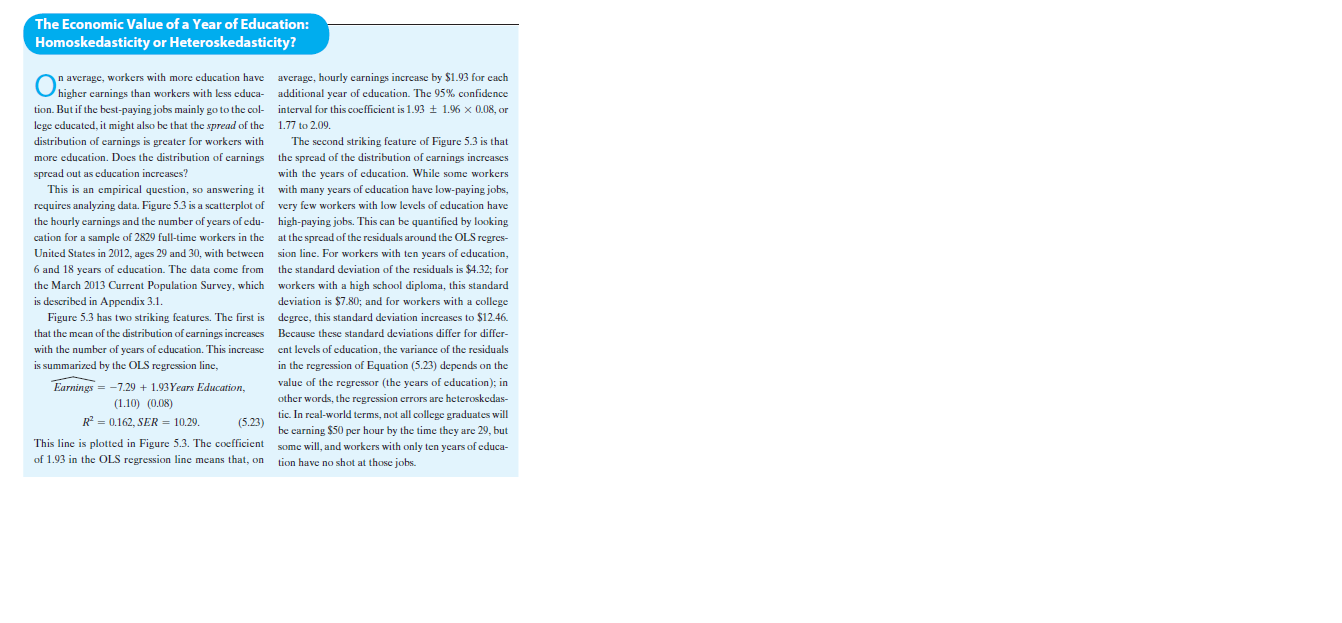The Economic Value of a Year of Education: Homoskedasticity or Heteroskedasticity? On average, workers with more education have average, hourly carnings increase by $1.93 for cach Ohigher carnings than workers with less cduca- additional year of education. The 95% confidence tion. But if the best-paying jobs mainly go to the col- interval for this coefficient is 1.93 + 1.96 x 0.08, or lege educated, it might also be that the spread of the 1.77 to 2.09. distribution of carnings is greater for workers with The second striking feature of Figure 5.3 is that more education. Docs the distribution of carnings the spread of the distribution of earnings increases with the years of education. While some workers This is an empirical question, so answering it with many years of education have low-paying jobs, spread out as education increases? requires analyzing data. Figure 5.3 is a scatterplot of very few workers with low levels of education have the hourly carnings and the number of ycars of edu- high-paying jobs. This can be quantified by looking at the spread of the residuals around the OLS regres- cation for a sample of 2829 full-time workers in the United States in 2012, ages 29 and 30, with between n sion line. For workers with ten years of education, 6 and 18 years of education. The data come from the standard deviation of the residuals is $4.32; for the March 2013 Current Population Survey, which workers with a high school diploma, this standard is described in Appendix 3.1. Figure 5.3 has two striking features. The first is degree, this standard deviation increases to $12.46. deviation is $7.80; and for workers with a college that the mean of the distribution of carnings increases Because these standard deviations differ for differ- with the number of years of education. This increase ent levels of education, the variance of the residuals is summarized by the OLS regression line, in the on the regression of Equation (5.23) depends value of the regressor (the years of education); in Earnings = -7.29 + 1.93Years Education, (1.10) (0.08) other words, the regression errors are heteroskedas- tic. In real-world terms, not all college graduates will R = 0.162, SER = 10.29. (5.23) be carning $50 per hour by the time they are 29, but This line is plotted in Figure 5.3. The coefficient of 1.93 in the OLS regression line means that, on some will, and workers with only ten years of educa- tion have no shot at those jobs.
Correlation
Correlation defines a relationship between two independent variables. It tells the degree to which variables move in relation to each other. When two sets of data are related to each other, there is a correlation between them.
Linear Correlation
A correlation is used to determine the relationships between numerical and categorical variables. In other words, it is an indicator of how things are connected to one another. The correlation analysis is the study of how variables are related.
Regression Analysis
Regression analysis is a statistical method in which it estimates the relationship between a dependent variable and one or more independent variable. In simple terms dependent variable is called as outcome variable and independent variable is called as predictors. Regression analysis is one of the methods to find the trends in data. The independent variable used in Regression analysis is named Predictor variable. It offers data of an associated dependent variable regarding a particular outcome.
Read the box “The Economic Value of a Year of Education: Homoskedasticity or Heteroskedasticity?” in the Attachment. Use the regression reported in Equation to answer the following.a. A randomly selected 30-year-old worker reports an education levelof 16 years. What is the worker’s expected average hourly earnings?b. A high school graduate (12 years of education) is contemplatinggoing to a community college for a 2-year degree. How much is thisworker’s average hourly earnings expected to increase?c. A high school counselor tells a student that, on average, college graduates earn $10 per hour more than high school graduates. Is this statement consistent with the regression evidence? What

Trending now
This is a popular solution!
Step by step
Solved in 3 steps with 5 images









